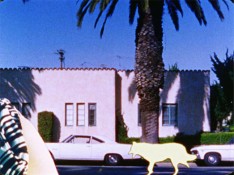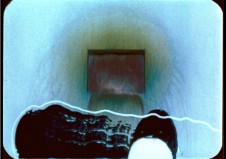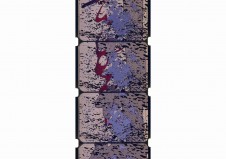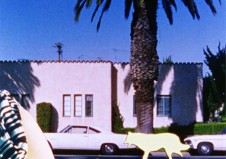Pat O’Neill: Spatial Affects

Foregrounds (1978) by Pat O'Neill
Pat O’Neill: Spatial Affects
Los Angeles Premieres of Painter and Ball 4-14 (2011) and Ojo Caliente (2012)!
Pat O’Neill in person!
Pat O’Neill, a founding father of the Los Angeles avant-garde film scene and a pioneer of optical effects, is perhaps best known for his highly graphic, layered, and reflexive film work. This program of short works, featuring two Los Angeles premieres, situates this important and singular artist within the broader context of contemporary art. In O’Neill’s films boundaries fade, narrative collapses, and multiple layers of imagery draw the viewer into the work, both suggesting and denying linear meaning. A master of experimental montage and compositing techniques, O’Neill has created a graphic language that focuses on the relationships between disparate elements assembled together in the frame. While his innovative optical techniques were prescient of our current digital landscape, his most recent work fully embraces the possibilities of this new technology. Formally rich, spatially ambiguous, and saturated with both color and feeling, O'Neill's films speak the language of painting while moving in time.

Saugus Series (1974) by Pat O'Neill
Saugus Series
(1974, 16mm, Color, Sound; 18 minutes)
Saugus Series, Sidewinders' Delta, and Foregrounds, made between 1974 and 1979, are each comprised of a number of individual sequences, separated from one another by intervals of black. Each of these sequences is made up of a number of image elements that are present throughout the duration of the scene. Scenes are edited into a continuity and accompanied by sound, but could, alternatively, be presented as separate experiences within a viewing space. Thus the present sequence is only one of many ways the film might be experienced, and no part of the film is particularly contingent upon any other part.
The common thread connecting the parts of these films is a fascination with ambiguous spaces, each made up of common representations that refute one another's existence.

Sidewinder's Delta (1976)
Sidewinder's Delta
(1976, 16mm, Color, Sound; 20 minutes)
When a giant trowel is plunged into the floor of Monument Valley, it's as though John Ford had hired Claes Oldenburg to dress his set. The film, O'Neill's most ambitious to date, with a dreamy, narrative subtext underlying its sensuous surface, is framed by abstract animations which denote scratches or scraped-off emulsion in much the same way that Roy Lichtenstein offered a benday-dot brushstroke as a painterly gesture. —J. Hoberman, The Village Voice

Foregrounds (1978)
Foregrounds
(1978, 16mm, color, sound; 14 minutes)
Foregrounds, like Saugus Series, is devoted almost entirely to carefully constructed spatial ambiguities. The most visceral of these prints a rotating boulder, occupying half of the screen, over a slow lateral pan across the desert (painted by Neon Park). A faint superimposition of leaves on top of the landscape has the effect of pushing its vista farther back in space. Correspondingly, the boulder bulges out of the picture-plane like a Cezanne apple. The effect is so strong that even when O'Neill begins to animate “scratches” over the image, one's eye refuses to surrender the illusion of volume. —J. Hoberman, The Village Voice
Painter and Ball 4-14
(2011, Digital Video, color, sound; 10 minutes)
Los Angeles Premiere!
Painter and Ball 4-14 is a conversation between two filmmakers, one living and the other deceased. Richard Matthews began filming out the window of his tiny Kansas studio in 1976, recording from time to time the passing of days and seasons on his Bolex. Richard didn't live to finish his intended film, and the Ektachrome originals came into my possession. I made a similar recording of a piece of woodland just outside my studio in Pasadena. In editing, the two recordings were placed one upon the other, so nightfall in Kansas became morning in California, and so on. To this was added another piece of action—a genderless, child-manikin enacting a series of rituals in which energy seems to enter its body through contact with the stamen of a flower, causing it to roll and twitch spasmodically, as in rapture or pain or ecstasy.
The title refers to the location, on a tract map, of the main image. Mr. Painter and Mr. Ball were land developers in the 1880s in Pasadena, California, who lent their evocative names to dozens of residential tracts. —Pat O’Neill
Ojo Caliente
(2012, Digital Video, Color, Sound; 4 minutes)
Los Angeles Premiere!
In the early 1970's, a team of anthropologists from the University of Bristol had come across a huge scattering of unexplained objects, hollow and conical or tubular in shape, lying strewn across several acres of a mesa near the abandoned village of Ojo Caliente on Huaraches Creek in Abraham County. These objects were made of a material that could not be easily identified. It seemed as if the processes of manufacture had taken place underground, though exploration of the cavern yielded little, as a collapse of the cavern's ceiling a dozen yards in had covered whatever had been there. A sample of the cone material had reached a laboratory of the Defense Department in Washington in 1975. After chemical analysis yielded the conclusion that the objects "consisted of a compound that had no explanation and no precedent in our experience,” a team of scientists was dispatched to the site to collect and secure all of the remaining cones. Then a fleet of Army tractors, loaders and dump trucks descended on Ojo Caliente and carted off every trace of the cones, the trailers, the rubbish, and all the earth that could be scooped up.
In 2010, I created a tiny replica in 1/87 scale of the center of the Ojo Caliente Site as I imagine it might have appeared when occupied. The resulting document reveals a place that may be a prototypical artist's studio of the coming century—a ruin in a wasteland in which to produce the signs of an alien or inexplicable culture. —Pat O’Neill
